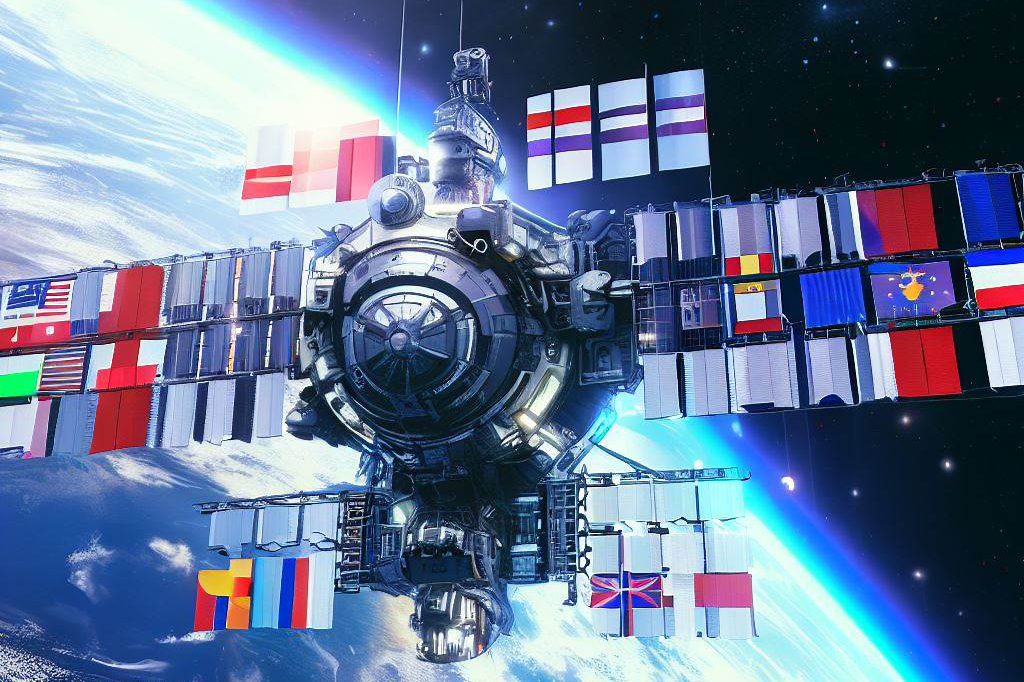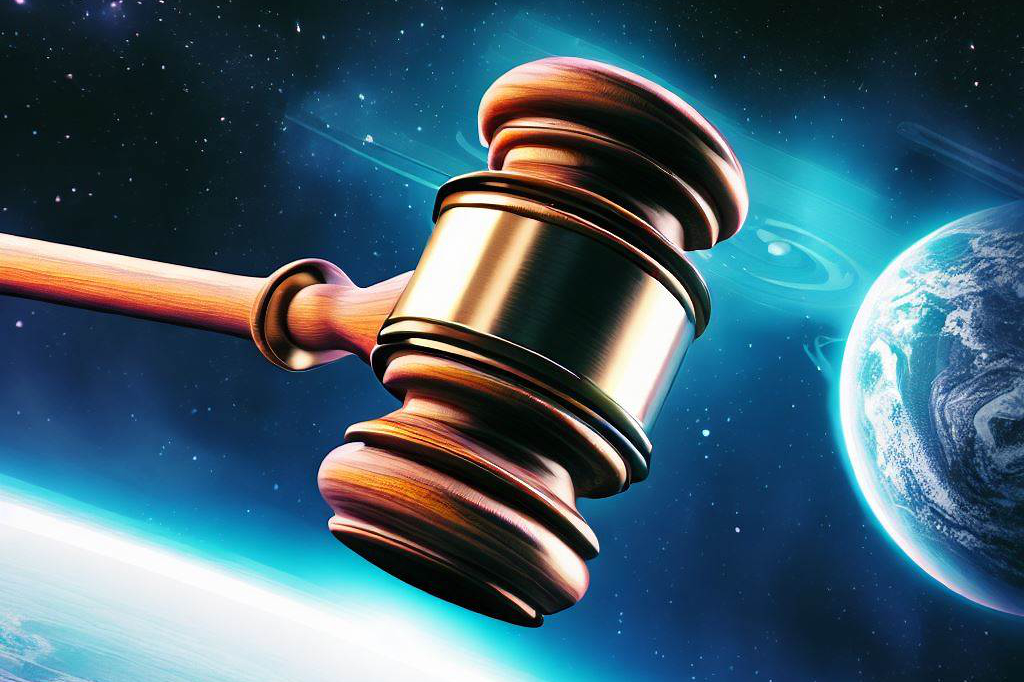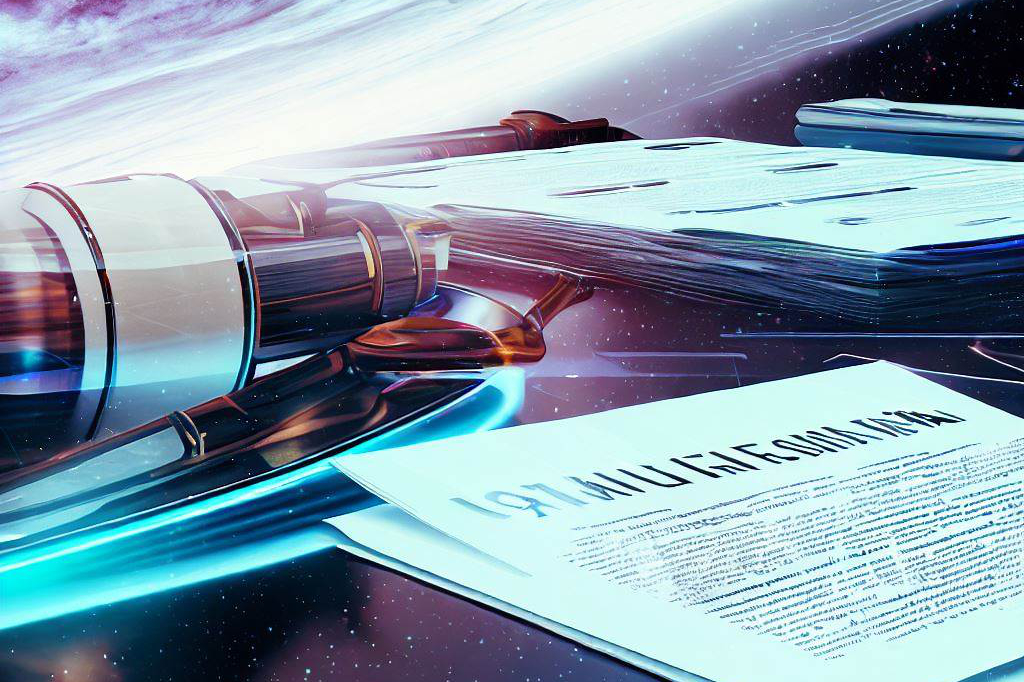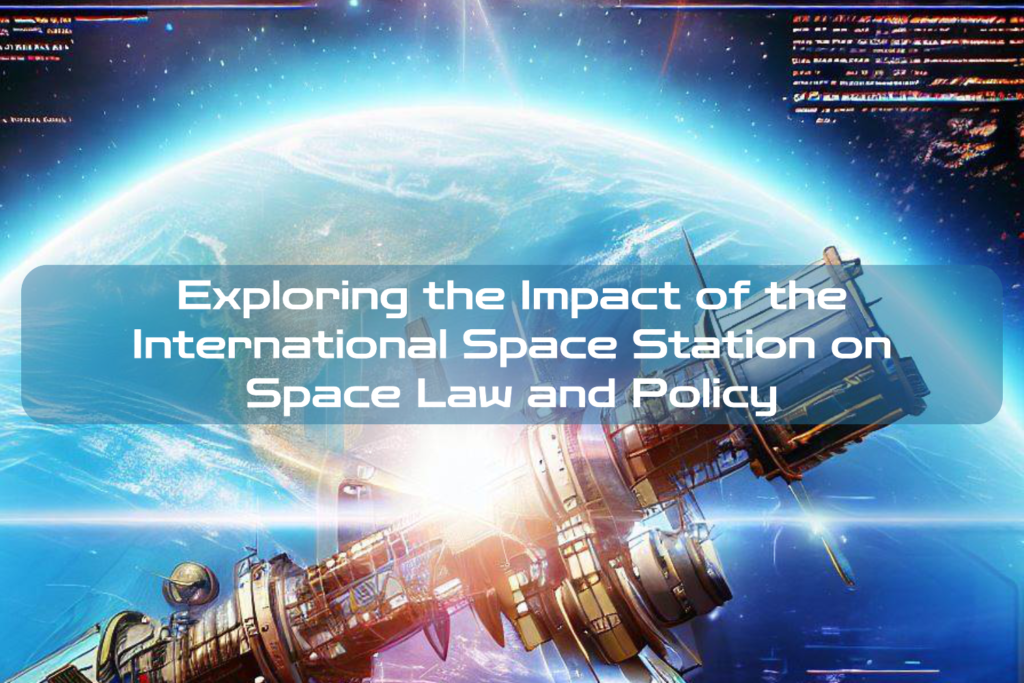The International Space Station (ISS) is a habitable artificial satellite in low Earth orbit. It is a joint project between five space agencies:
The ISS has been continuously inhabited since November 2000, with the current crew consisting of astronauts from the United States, Russia, and Japan.
The ISS serves as a platform for scientific research and technological development in various fields such as biology, physics, astronomy, and medicine. It also serves as an important symbol of international cooperation in the realm of space exploration.
Importance of space law and policy
Space law refers to the body of law that governs space-related activities. It includes international treaties, national laws and regulations, as well as industry standards and guidelines.
Space policy refers to the goals, objectives, principles, guidelines, and strategies adopted by governments or other organizations related to space activities.
Space law is important because it provides a framework for regulating activities in outer space, including issues like
- liability for damages caused by objects launched into outer space;
- conduct of astronauts;
- ownership rights over celestial bodies;
- satellite communications;
- environmental protection among others.
Similarly, space policy helps guide decision makers on priorities in allocating resources towards research programs or missions.
Both space law and policy are crucial components for governing activities in outer space with respect to safety considerations relating to humans on Earth as well as ensuring an equitable distribution of opportunities within the field of astronomy.
The ISS as a Platform for International Cooperation

History of the ISS and Its Multinational Partnerships
The International Space Station (ISS) was launched into orbit in 1998 and has been continuously inhabited since November of 2000.
The idea for a collaborative space station dates back to the early 1980s when President Ronald Reagan proposed an international space exploration initiative. After years of planning, development, and collaboration between the United States, Russia, Europe, Canada, and Japan, the ISS became a reality.
The multinational partnerships involved in creating the ISS have been crucial to its success. NASA led the project with support from other countries’ space agencies.
Russia provided key components such as modules for living quarters and communications systems. The European Space Agency contributed science laboratories, while Japan’s space agency provided research facilities.
Benefits of International Cooperation in Space Exploration and Research
International cooperation in space exploration has brought significant benefits to each participating country’s scientific community by allowing access to unique research opportunities not available elsewhere. The ISS is much more than just a laboratory floating around Earth; it serves as an outstanding example of successful international collaboration among countries with diverse cultures and political systems.
The ability to share scientific knowledge across borders is one critical benefit that comes with cooperating on projects like the ISS. Scientists from different nations work together on experiments that help answer fundamental questions about our universe while also discovering new technologies that enhance our lives here on Earth.
Moreover, international cooperation is vital for ensuring long-term sustainability in space exploration endeavours such as human exploration missions to Mars or even beyond our solar system someday. By working together towards common goals through initiatives like the ISS program, countries can reduce their costs while simultaneously increasing their capabilities and knowledge base for future missions beyond low earth orbit.
The Legal Framework Governing the ISS

Overview of Relevant Treaties and Agreements
The International Space Station (ISS) is governed by a complex web of international treaties and agreements. The most important of these is the Outer Space Treaty, which was signed in 1967 and sets out the basic principles governing space activities.
Among other things, the treaty prohibits countries from claiming sovereignty over any part of outer space, requires that all activities be carried out for peaceful purposes, and establishes liability for damage caused by space objects. In addition to the Outer Space Treaty, there are several other treaties and agreements that apply specifically to the ISS.
One of these is the ISS Intergovernmental Agreement (PDF), which was signed in 1998 by all participating countries. This agreement outlines the legal framework for cooperation on the design, development, operation, and use of the ISS.
Responsibilities of Participating Countries
All participating countries in the ISS program have certain responsibilities under international law to ensure compliance with space law.
These responsibilities include providing assurances that their activities will be carried out in accordance with international law, ensuring that their personnel are trained in space law and policy issues, and taking all necessary steps to prevent damage or interference with other countries’ activities.
In addition to these general responsibilities, each participating country has specific obligations under the various treaties and agreements governing the ISS.
For example, each country must ensure that its astronauts comply with applicable laws while on board the station; provide indemnification against third-party claims arising from its activities; and take measures to prevent harmful interference with other countries’ activities.
Overall, ensuring compliance with space law is a complex task that requires close cooperation among participating countries. While there have been some challenges along the way – such as disagreements over intellectual property rights – overall cooperation on legal issues has been a key success factor in making this groundbreaking project possible.
Scientific Research on the ISS

What Happens Up There?
While the ISS is primarily known for being an orbiting laboratory in space, what happens inside it can be a mystery to many. The truth is that there are a wide variety of experiments happening on the ISS at any given time, from studying plant growth in microgravity to monitoring astronaut health during long-duration space flights. NASA and its partners regularly conduct groundbreaking research in fields such as medicine, physics, and materials science aboard the station.
Examples of Scientific Experiments Conducted on the ISS
One recent experiment conducted on the ISS was designed to study how microgravity affects our ability to fight infections. Researchers infected mice with salmonella and studied their immune response over time while altering various environmental factors such as light exposure and air quality.
This study could help us develop better treatments for infections not only in space but here on Earth as well. Another experiment involves growing crops in space.
Since plants behave differently without gravity pulling them down, researchers are studying how they can adjust growth parameters like light exposure to optimize crop yields even with limited resources. Someday soon, we may be growing our food not just here on this planet but also beyond it!
How Research on the ISS Contributes to Advancements in Various Fields
The International Space Station has contributed significantly to advancements across a number of scientific fields, including medicine and materials science. For example, researchers have used data collected aboard the station to develop new medical treatments ranging from improved vaccines against infectious diseases like influenza to new prosthetics that use advanced materials designed specifically for use in microgravity environments.
In addition, ongoing scientific research has led to advances in areas such as energy storage technology and even 3D printing capabilities that could one day allow us to manufacture complex structures like houses or spacecraft components off-world! All of these innovations and more are made possible by the unique environment that the ISS provides for scientific experimentation.
Commercial Activities on the ISS

Opportunities for Private Astronaut Missions and Marketing Initiatives
The International Space Station (ISS) has become a platform for commercial activities in recent years. One of the most exciting developments is the opportunity to send private astronauts to the ISS. Companies like SpaceX and Boeing are developing spacecraft that will allow tourists to visit the space station and experience life in orbit.
These missions will not only provide a unique experience for paying customers, but they will also offer a new source of revenue for space agencies. In addition to private astronaut missions, companies also have opportunities for marketing initiatives on the ISS.
For example, PepsiCo partnered with Russian space agency Roscosmos to launch an advertisement campaign featuring a zero-gravity soda can. This type of marketing initiative is not just limited to food and beverage brands; any company interested in space exploration could potentially use the ISS as a platform for advertising.
Challenges Associated with Regulating Commercial Activities in Space
As exciting as these developments are, they also present challenges when it comes to regulating commercial activities in space. The Outer Space Treaty, which governs all activities in space, was created before commercial ventures were even considered as possibilities. As such, there are currently no clear regulations when it comes to activities such as private astronaut missions or marketing campaigns on the ISS.
Furthermore, there are concerns about how commercial ventures may impact scientific research conducted on the ISS. If too many resources are devoted to profit-making activities, it could detract from valuable research opportunities that benefit humanity as a whole.
There is also concern about how these ventures could exacerbate tensions between participating countries if certain nations perceive others as having an unfair advantage or unequal access to commercial opportunities on the ISS. Overall, while there are exciting prospects for commercial activity on the ISS, careful consideration must be taken into account regarding regulation and balancing the needs of scientific research with economic interests.
Future Implications for Space Law and Policy

Potential Changes to Existing Laws to Accommodate New Technologies or Emerging Challenges
As technology continues to advance, space law and policy must keep pace. One of the biggest challenges facing policymakers is how to regulate new technologies that are not explicitly covered by existing laws.
For example, as private companies begin planning missions to mine asteroids for resources, there are questions about who owns those resources and how they can be used.
Similarly, as more countries develop the capability to launch their own satellites, there is a need for clearer regulations around satellite collisions and debris. To address these emerging challenges, some experts have called for updates to existing space treaties and agreements.
One proposal is a new “Moon Treaty” that would govern activities on the moon much like the Outer Space Treaty does for other celestial bodies. Others have suggested creating an international governing body specifically focused on space law and policy.
Importance of Continued International Cooperation in Shaping Future Policies
As we look ahead to the future of space law and policy, one thing is clear: international cooperation will remain crucial. The ISS provides a model for what can be achieved through multinational partnerships in space exploration and research.
By working together, countries can share the costs and risks associated with space missions while also pooling their expertise. However, there are challenges associated with maintaining this level of cooperation over time.
As political climates change in different countries, priorities may shift away from space exploration or funding may be cut due to economic concerns. To ensure that international cooperation continues in this area, policymakers will need to make a persuasive case for why it matters.
One argument is that investing in space exploration has numerous benefits beyond just scientific discoveries – it can also lead to practical applications in fields like medicine or materials science. Another argument is that continued collaboration in space could foster greater diplomatic ties between nations, even in times of political tension.
The Future of Space Law and Policy
As we look to the future, there are many unanswered questions about what the next generation of space law and policy will look like. Will existing treaties be updated to reflect new technologies and emerging challenges? Will there be more regulation around commercial activities in space?
And what new opportunities or challenges will arise as we continue to explore the cosmos? One thing is certain – advances in technology will continue to push the boundaries of what is possible in space.
As we navigate these new frontiers, it will be crucial for policymakers to strike a balance between promoting innovation while also ensuring that activities in space are conducted safely and responsibly. By working together across international borders, we can create a framework that encourages continued exploration while also protecting our shared resources beyond Earth’s atmosphere.
Final Thoughts: The International Space Station and the Future of Space Law and Policy

The International Space Station is a remarkable achievement of international cooperation in space exploration and research. Since its launch in 1998, the ISS has served as a platform for groundbreaking scientific research, technological advancements, and commercial activities. However, it is also important to recognize the significant role that space law and policy play in governing activities in space.
One of the key takeaways from our discussion is that international cooperation is crucial for successful space exploration. The ISS represents a shining example of how nations can work together towards a common goal, with each participant contributing their unique expertise towards achieving shared objectives.
As we look to future missions to Mars and beyond, it will be essential to continue this spirit of collaboration. Another important takeaway is that while there are existing laws governing activities in space, there are still many challenges associated with regulating commercial activities and emerging technologies.
As new opportunities arise for private companies to engage in activities such as mining on asteroids or establishing permanent settlements on other planets, it will be critical for policymakers to consider how best to balance innovation with safety and sustainability. Ultimately, what the International Space Station teaches us is that progress in space requires not only technological advancement but also political willpower.
By working together through international agreements such as the Outer Space Treaty and the ISS Intergovernmental Agreement, nations have been able to establish a legal framework for shared activity beyond Earth’s atmosphere. As we look towards future missions and opportunities beyond low-Earth orbit, it will be up to all of us – policymakers, scientists, and engineers – to build upon this legacy of cooperation so that humanity can continue pushing forward into new frontiers.

C M, a seasoned editor, journalist, and consultant, is deeply fascinated by the convergence of technology, space, and the future of humanity.
With a particular interest in transhumanity, futurology, and the philosophical and ethical dimensions of these domains, C M serves as the lead contributor to SpaceSpotlight and TranscendSphere.
When not penning insightful articles on these rapidly evolving fields, C M indulges in their love for podcasts and books, proudly embracing their status as a ‘Happy Nerd Extraordinaire!’



